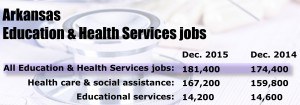Obamacare, increasing health care coverage to fuel industry job growth, spending over next decade
by March 22, 2016 3:12 pm 301 views

Editor’s note: This is the first of two stories about rising employment in Arkansas’ education and health services sector. The second story is scheduled to be posted Wednesday (March 23), and will include comments from hospital administrators and executives.
–––––––––––––––
Recent employment projections for Arkansas and the rest of the nation show that the advent of Obamacare and the addition of more than 20 million Americans to public or private health insurance rolls is dramatically changing the landscape of the nation’s job market.
That’s been evident in Arkansas, where health care jobs have helped absorb the economic hit of the dwindling manufacturing sector. There were 167,200 health care and social assistance jobs in Arkansas in December 2015, up 7,400 jobs compared to December 2014, and up an impressive 43% compared to the 117,000 jobs in December 2000.
Arkansas’ manufacturing jobs in the 15 years are down almost 35%, falling from 237,400 in December 2000 to 154,600 in December 2015.
According to data from the Centers for Medicare & Medicaid Services, U.S. health care spending increased 5.3% in 2014 to reach $3 trillion, or $9,523 per person, compared to growth of 2.9% in 2013. The share of the economy or Gross National Product (GDP) devoted to health care spending in 2014 was 17.5%, up from 17.3% in 2013.
And that growth has continued well into 2015 and 2016, a recent report from the Altarum Institute shows. The Ann Arbor, Mich.-based think tank noted in a report posted March 11 that national health spending in January 2016 was 4.9% higher than a year ago and slightly above the December 2015 growth rate of 4.8% but well below the 6.8% peak in February 2015. The bipartisan Michigan research group said full-year health spending grew by 5.9% in 2015, with the health spending share of GDP at 18.1% in December.
“The jump in the health spending growth rate to 5.9% in 2015 appears to be temporary, with growth trending below 5% as we approach 2016,” said Charles Roehrig, founding director of the center. “This pattern is consistent with the expectation that spending growth would increase with expanded coverage and then drop back as coverage levelled off. The latest spurt in health sector hiring is a bit at odds with the spending slowdown, and it will be interesting to see how this resolves in the coming months.”

That stands in contrast to 2004 to 2014, when health care added only about 250,000 jobs per year. But in just the past two years, which incidentally coincides with the expansion of the Affordable Care Act, jobs in health care have grown at an annualized rate of 400,000 to 500,000 per year.
In Arkansas, the state’s nonfarm payroll employment in 2015 bears out the national trend. Employment in health care and social assistance, which is part of the education and health services “supersector,” saw a robust 4.6% jump of 7,400 jobs between December 2014 and December 2015. Of the total 181,400 jobs in education and health services, 167,200 of those positions were affiliated with the health care field.
The recent growth, according to BLS data, goes back to 2012 when the debate over the Affordable Care Act (ACA) was in full swing. During that time, Arkansas and the rest of the nation were already seeing the role health care was playing in the state’s short-term and long-term employment outlook.
BOOSTING PROJECTIONS
While total U.S. employment four years ago was projected to increase 10.8%, or 15.6 million, labor department officials began changing their U.S. employment outlook when data began showing that industries related to health care would add more jobs to the U.S. economy than previously expected.
“In the coming decade, demographic changes are expected to have pervasive effects on the nation’s economic outlook. As individuals age, their consumption patterns change and their demand for health care and related services rises,” said Maggie Woodward, economist in the Office of Occupational Statistics and Employment Projections of the U.S. Bureau of Labor Statistics. “These trends are expected to play an important role in sectoral growth of output and employment. In addition, by expanding insurance coverage to millions of Americans, the Patient Protection and Affordable Care Act will place even greater demands on the health care system.”
Today, the Labor Department now projects that eight of the 10 fastest-growing occupations between 2014 and 2014 will be associated with the health care industry, ranging from highly-paid optometrist and nurse practitioners to home health and personal care aides on the lower end of the scale.
The median annual wage for healthcare practitioners and technical occupations (such as registered nurses, physicians and surgeons, and dental hygienists) was $61,710 in May 2014, which was higher than the median annual wage for all occupations in the economy of $35,540. Healthcare support occupations (such as home health aides, occupational therapy assistants, and medical transcriptionists) had a median annual wage of $26,440 in May 2014, lower than the median annual wage for all occupations in the economy.
A ‘PRIVATE OPTION’ BOOST
The BLS data also shows states that expanded health insurance access under ACA have seen substantially faster growth in healthcare jobs than those that did not since the first expansions began 2014. According to Labor Department statistics, healthcare and social assistance jobs grew more than 30% faster between December 2013 and December 2014 in 24 states that implemented ACA expansion on Jan. 1, 2014 than those that did not. On average, those states, including Arkansas, saw jobs in the healthcare and the social-assistance sectors grow by 2.4% year-over-year. Twenty-four states that didn’t expand grew at 1.8%.
In a recent analysis report, Fitch Ratings service said gains in healthcare jobs suggest that ACA expansion is generally positive for that sector’s employment profile.
“However, the ACA is very broad legislation with a wide range of effects on state economies and budgets,” said the Wall Street credit ratings service. “We believe this healthcare job growth would need to continue into the longer term to be directly attributable to the ACA. Furthermore, it is uncertain how improvements like this will compare to other budget issues. The states that expanded ACA are also more exposed to potential federal deficit reduction efforts than non-expanding states.”
Next month, Arkansas lawmakers will come to Little Rock to consider Gov. Asa Hutchinson’s plan to continue the private option, also known as Arkansas Works. If enacted, Arkansas Works would modify the Medicaid expansion began under the private option, the program that uses federal Medicaid dollars to purchase private health insurance for adult Arkansans with incomes above 138% of the federal poverty line. The private option was created in 2013 and now covers more than 200,000 Arkansans. It ends at the end of 2016.
The Arkansas Health and Jobs Coalition, a group of 30 organizations formed in 2013 to support the creation of the private option, recently offered their backing again to Gov. Hutchinson.
